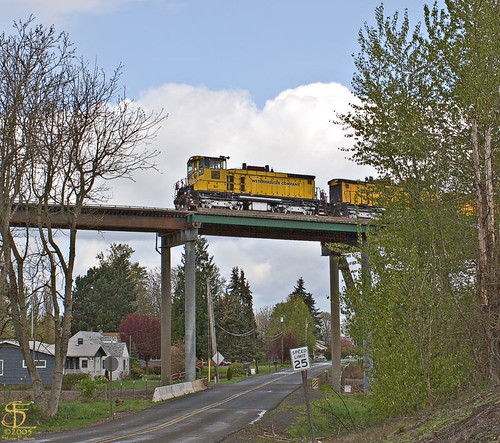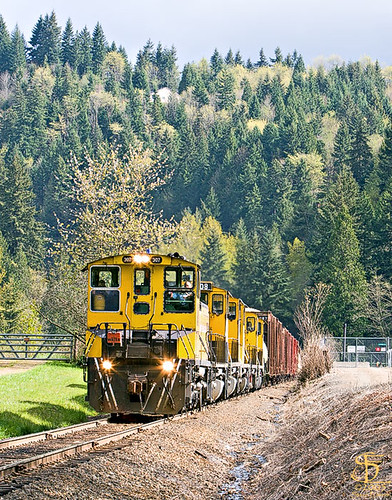Model What Again?
Now that I've whined about the problem, now comes the fun part - solving it.
What grabs you about trains? The equipment? The railroad company? The scenery?
The sight of trains dwarfed by magnificent mountain scenery? Or the sight of a dirty switcher shoving a couple of boxcars down a gritty industrial alley?
If some asks you to imagine a train - what do you conjure?
Take a good long look at that image - that is a good start for thinking about your own model railroad.
Also, take full advantage of the modeling resources out there - they are a treasure trove of ideas. And those ideas can appear at any time. Some suggestions:
- Realistic Model Railroad Design, by Tony Koester. Mr. Koester is a name you will run into often, and for good reason. He could probably be considered the chief philosopher of model railroading. Not because of his ideas - but because of his ability to communicate them. He has rendered tacit much of what makes a model railroad seem like the real thing.
- Realistic Model Railroad Operation, by Tony Koester. If you know how and why the real thing operates, you can understand how to model it. And want to model it right.
- Track Planning for Realistic Operation, by John Armstrong. Mr. Armstrong is still known as "The Dean of Track Planning." This book will show you why, and its advice and methodology are extremely helpful when it comes down to building the railroad you can have - rather than the one you want, for which you need an acre-sized barn.
- Model Railroader magazine, and its annuals, Great Model Railroads and Model Railroad Planning.
- Especially Model Railroad Planning. It is devoted to articles by people who have just been where you and I now are.
- Railroad Model Craftsman - especially their issues that feature a "Railroad You Can Model" article.
And don't be afraid to change your mind. I'm not the best example of this, since I've allowed "analysis paralysis" to stymie me for three years now, but keep in mind that you are allowed to change your mind. It can be expensive, but there is nothing saying you have to model the same thing forever.
It's a hobby. Have fun with it. If you're not having fun anymore - change it.
All right - so what am I doing with it? You would have to ask.

Steve Eschom at RailroadForums.com
Imagine, if you will, a bustling Pacific Northwest seaport city. Its docks send off the grain, logs, lumber, and coal of the American West and Midwest overseas, and accepts the autos and containers of consumer goods from Asia. Such a bustling port needs a good strong link to the rest of the nation - and one such link will be my railroad.
Also imagine, the backroads leading out of that port, the farm towns and mill towns that raise the grain and cut and saw the timber. They need a link to the rest of the country - including that aforementioned seaport.
In addition, the Pacific Northwest has all these neat little branchlines and shortlines. Some connect mill towns to the mainlines. Others service industrial trackage in port cities. Some, like the Weyerhaeuser railroad pics shown here, are logging railroads. And some of those shortlines aren't that short, like the Port of Tillamook Bay Railroad.
So - I'm going to to a little bit of all of it. I have narrowed my timeline down to Burlington Northern's days, running from the 1970s into the mid-1980s. I'm going to cheat on that a little, though; while they won't be part of every operating session, there will be double-stack container trains. And they will be run with cabooses, another part of that cheating. (By the time double-stack trains got really big, cabooses were a disappearing part of the past. They weren't gone, but they were pretty hard to find.)
BN and a yet-to-be-named free-lance regional railroad will be the big players. The disappearance of the Milwaukee Road from the PNW in 1980 left a lot of trackage without an operator. Rather than scrap it all, the state of Washington tried to keep it operating. Making a deal with BN, who decided they could use some extra capacity and a route around Seattle to their Cascade mainline at Everett via the old Milwaukee main from Tacoma to Snoqualmie and Milwaukee's Everett branch. (Yes, there is some gratuitous abuse of actual railroad history here. Work with me.) So, the regional operates the old Tacoma Eastern, with some trackage rights into Portland, the Milwaukee main from Tacoma to Cedar Falls, and the old Milwaukee Everett branch. BN is a major stockholder in this line, as is the State of Washington. Traffic is largely carload traffic (i.e. boxcars, tank cars, hoppers - rather than container trains). Some BN run-through trains operate as well.
Connecting at various points are a port industrial line, the Port of Undecided-City Terminal, and a logging line, the McPherson Timber Company.
Chief inspiration for this delusion, er, vision? Ken Gentili's Puget Sound Southern from the January 1995 Model Railroader.
Now, I start trying to figure out how to pull this off.

Steve Eschom at RailroadForums.com